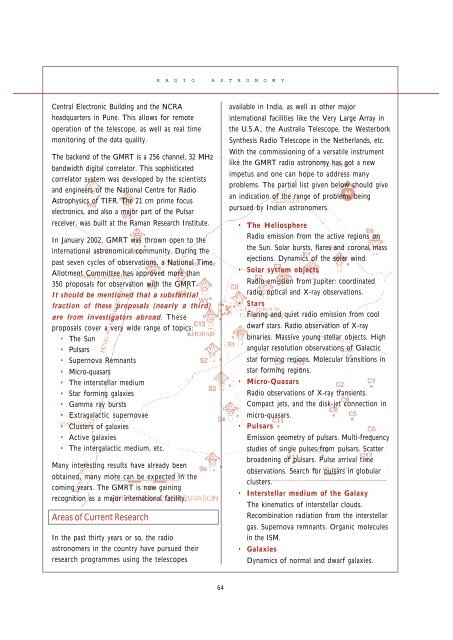2004 ASTRONOMY & ASTROPHYSICS - Indian Academy of Sciences
2004 ASTRONOMY & ASTROPHYSICS - Indian Academy of Sciences
2004 ASTRONOMY & ASTROPHYSICS - Indian Academy of Sciences
You also want an ePaper? Increase the reach of your titles
YUMPU automatically turns print PDFs into web optimized ePapers that Google loves.
RADIO <strong>ASTRONOMY</strong><br />
Central Electronic Building and the NCRA<br />
headquarters in Pune. This allows for remote<br />
operation <strong>of</strong> the telescope, as well as real time<br />
monitoring <strong>of</strong> the data quality.<br />
The backend <strong>of</strong> the GMRT is a 256 channel, 32 MHz<br />
bandwidth digital correlator. This sophisticated<br />
correlator system was developed by the scientists<br />
and engineers <strong>of</strong> the National Centre for Radio<br />
Astrophysics <strong>of</strong> TIFR. The 21 cm prime focus<br />
electronics, and also a major part <strong>of</strong> the Pulsar<br />
receiver, was built at the Raman Research Institute.<br />
In January 2002, GMRT was thrown open to the<br />
international astronomical community. During the<br />
past seven cycles <strong>of</strong> observations, a National Time<br />
Allotment Committee has approved more than<br />
350 proposals for observation with the GMRT.<br />
It should be mentioned that a substantial<br />
fraction <strong>of</strong> these proposals (nearly a third)<br />
are from investigators abroad. These<br />
proposals cover a very wide range <strong>of</strong> topics:<br />
• The Sun<br />
• Pulsars<br />
• Supernova Remnants<br />
• Micro-quasars<br />
• The interstellar medium<br />
• Star forming galaxies<br />
• Gamma ray bursts<br />
• Extragalactic supernovae<br />
• Clusters <strong>of</strong> galaxies<br />
• Active galaxies<br />
• The intergalactic medium, etc.<br />
Many interesting results have already been<br />
obtained, many more can be expected in the<br />
coming years. The GMRT is now gaining<br />
recognition as a major international facility.<br />
Areas <strong>of</strong> Current Research<br />
In the past thirty years or so, the radio<br />
astronomers in the country have pursued their<br />
research programmes using the telescopes<br />
available in India, as well as other major<br />
international facilities like the Very Large Array in<br />
the U.S.A., the Australia Telescope, the Westerbork<br />
Synthesis Radio Telescope in the Netherlands, etc.<br />
With the commissioning <strong>of</strong> a versatile instrument<br />
like the GMRT radio astronomy has got a new<br />
impetus and one can hope to address many<br />
problems. The partial list given below should give<br />
an indication <strong>of</strong> the range <strong>of</strong> problems being<br />
pursued by <strong>Indian</strong> astronomers.<br />
• The Heliosphere<br />
Radio emission from the active regions on<br />
the Sun. Solar bursts, flares and coronal mass<br />
ejections. Dynamics <strong>of</strong> the solar wind.<br />
• Solar system objects<br />
Radio emission from Jupiter: coordinated<br />
radio, optical and X-ray observations.<br />
• Stars<br />
Flaring and quiet radio emission from cool<br />
dwarf stars. Radio observation <strong>of</strong> X-ray<br />
binaries. Massive young stellar objects. High<br />
angular resolution observations <strong>of</strong> Galactic<br />
star forming regions. Molecular transitions in<br />
star forming regions.<br />
• Micro-Quasars<br />
Radio observations <strong>of</strong> X-ray transients.<br />
Compact jets, and the disk-jet connection in<br />
micro-quasars.<br />
• Pulsars<br />
Emission geometry <strong>of</strong> pulsars. Multi-frequency<br />
studies <strong>of</strong> single pulses from pulsars. Scatter<br />
broadening <strong>of</strong> pulsars. Pulse arrival time<br />
observations. Search for pulsars in globular<br />
clusters.<br />
• Interstellar medium <strong>of</strong> the Galaxy<br />
The kinematics <strong>of</strong> interstellar clouds.<br />
Recombination radiation from the interstellar<br />
gas. Supernova remnants. Organic molecules<br />
in the ISM.<br />
• Galaxies<br />
Dynamics <strong>of</strong> normal and dwarf galaxies.<br />
64
















